TOYOTA C-HR 2022 Owners Manual
Manufacturer: TOYOTA, Model Year: 2022, Model line: C-HR, Model: TOYOTA C-HR 2022Pages: 818, PDF Size: 113.75 MB
Page 451 of 818
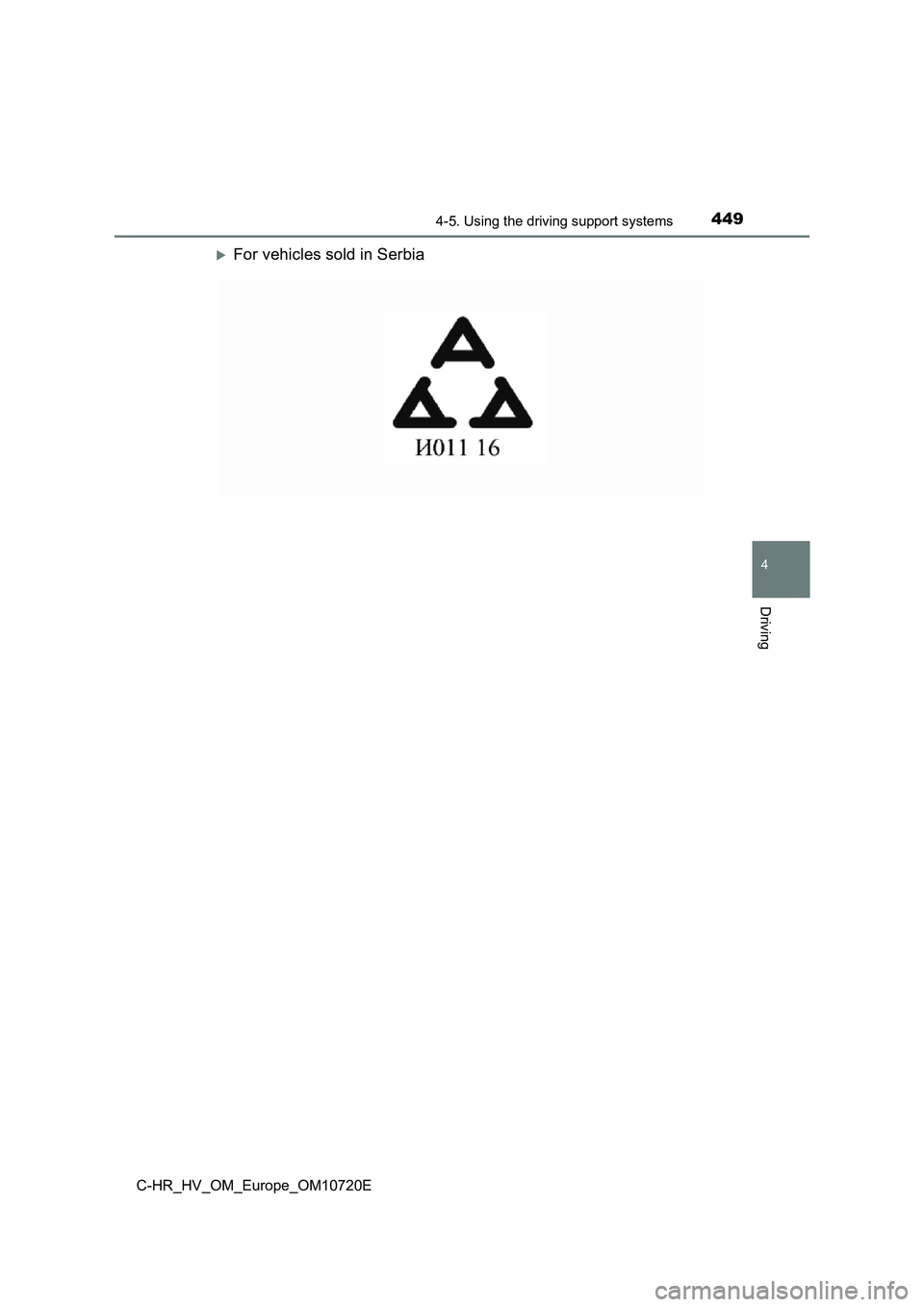
4494-5. Using the driving support systems
4
Driving
C-HR_HV_OM_Europe_OM10720E
For vehicles sold in Serbia
Page 452 of 818
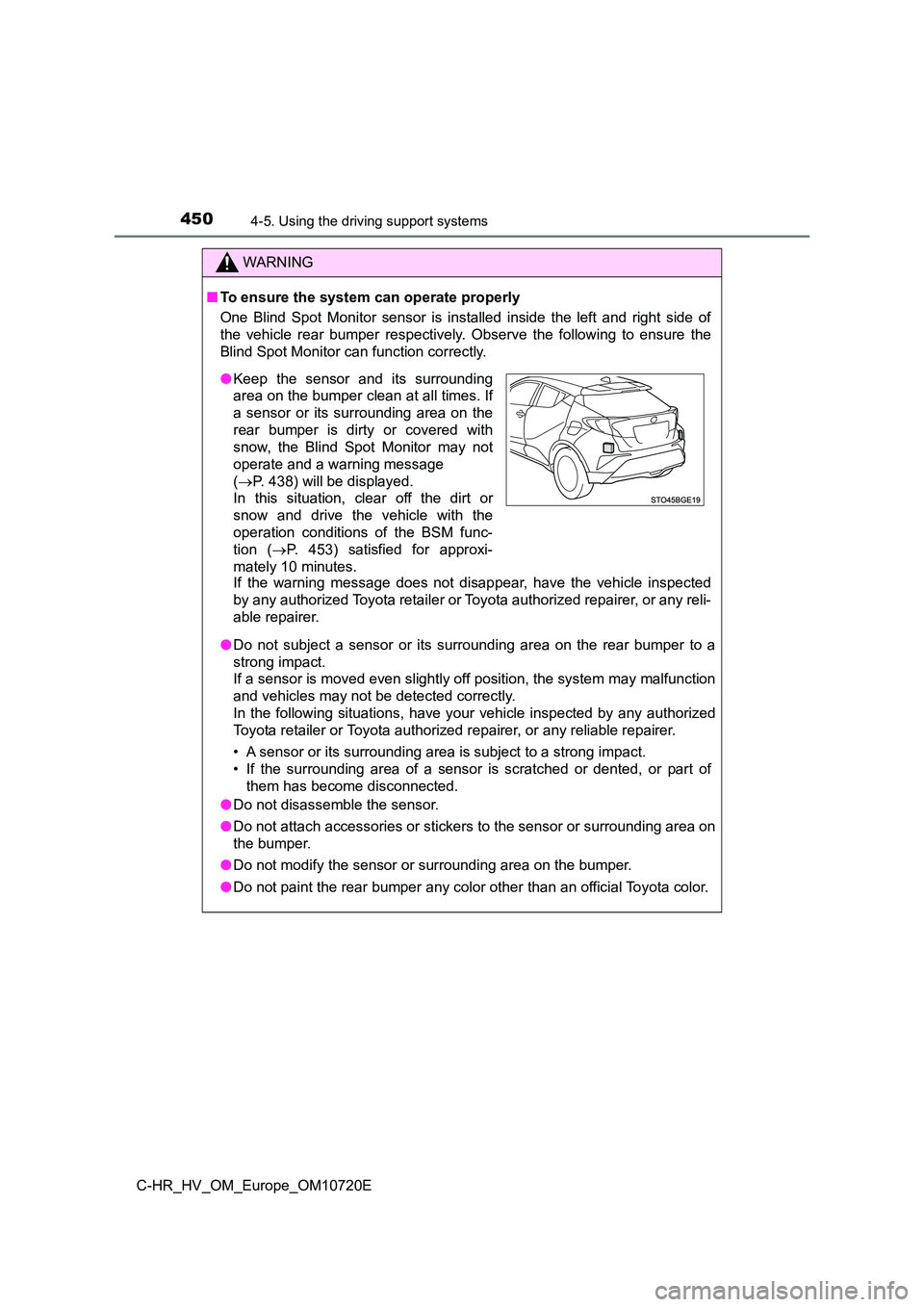
4504-5. Using the driving support systems
C-HR_HV_OM_Europe_OM10720E
WARNING
■To ensure the system can operate properly
One Blind Spot Monitor sensor is installed inside the left and right side of
the vehicle rear bumper respectively. Observe the following to ensure the
Blind Spot Monitor can function correctly.
If the warning message does not disappear, have the vehicle ins pected
by any authorized Toyota retailer or Toyota authorized repairer , or any reli-
able repairer.
● Do not subject a sensor or its surrounding area on the rear bumper to a
strong impact.
If a sensor is moved even slightly off position, the system may malfunction
and vehicles may not be detected correctly.
In the following situations, have your vehicle inspected by any authorized
Toyota retailer or Toyota authorized repairer, or any reliable repairer.
• A sensor or its surrounding area is subject to a strong impact .
• If the surrounding area of a sensor is scratched or dented, or part of
them has become disconnected.
● Do not disassemble the sensor.
● Do not attach accessories or stickers to the sensor or surrounding area on
the bumper.
● Do not modify the sensor or surrounding area on the bumper.
● Do not paint the rear bumper any color other than an official Toyota color.
●Keep the sensor and its surrounding
area on the bumper clean at all times. If
a sensor or its surrounding area on the
rear bumper is dirty or covered with
snow, the Blind Spot Monitor may not
operate and a warning message
( P. 438) will be displayed.
In this situation, clear off the dirt or
snow and drive the vehicle with the
operation conditions of the BSM func-
tion ( P. 453) satisfied for approxi-
mately 10 minutes.
Page 453 of 818
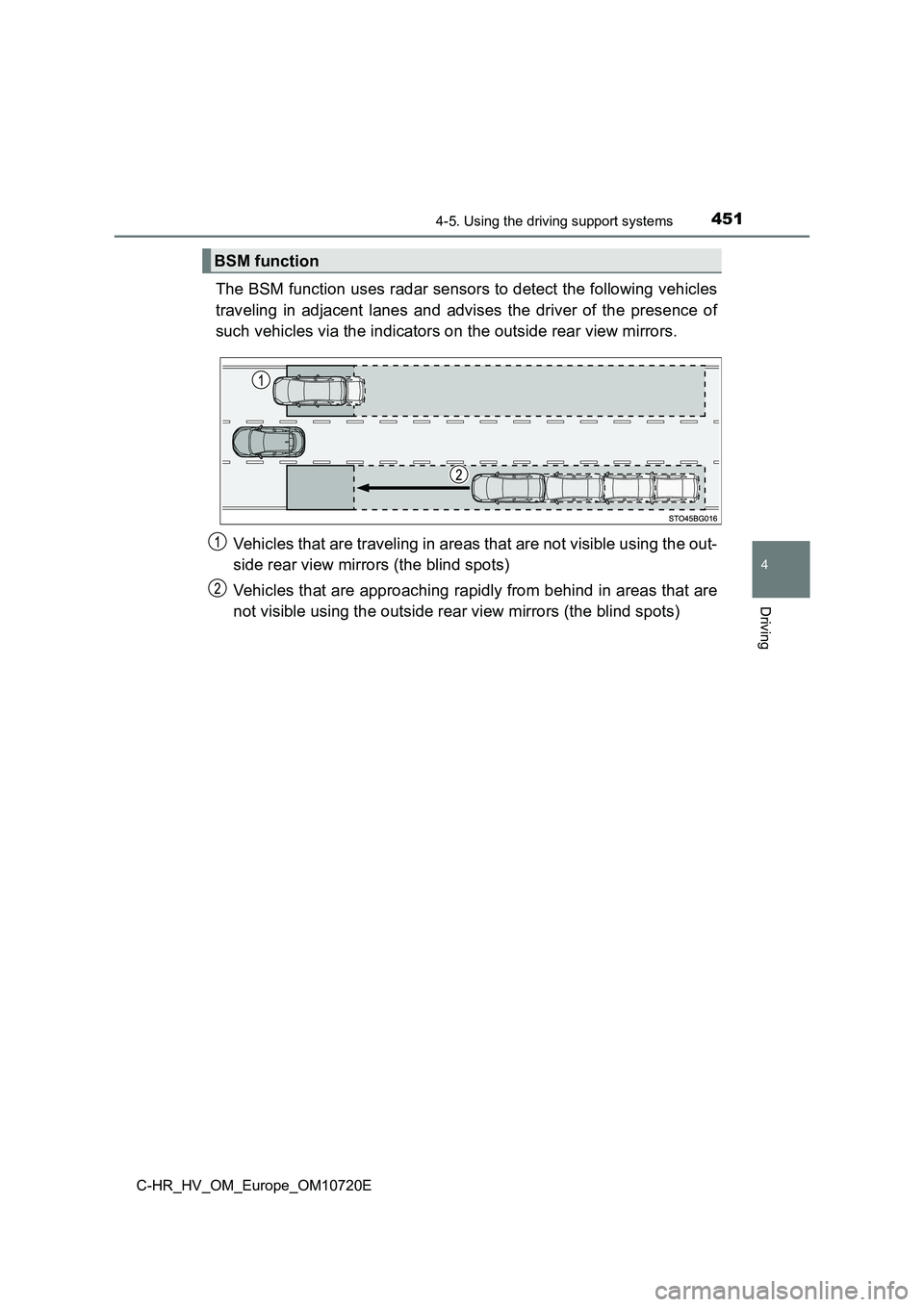
4514-5. Using the driving support systems
4
Driving
C-HR_HV_OM_Europe_OM10720E
The BSM function uses radar sensors to detect the following vehicles
traveling in adjacent lanes and advises the driver of the prese nce of
such vehicles via the indicators on the outside rear view mirro rs.
Vehicles that are traveling in areas that are not visible using the out-
side rear view mirrors (the blind spots)
Vehicles that are approaching rapidly from behind in areas that are
not visible using the outside rear view mirrors (the blind spot s)
BSM function
Page 454 of 818
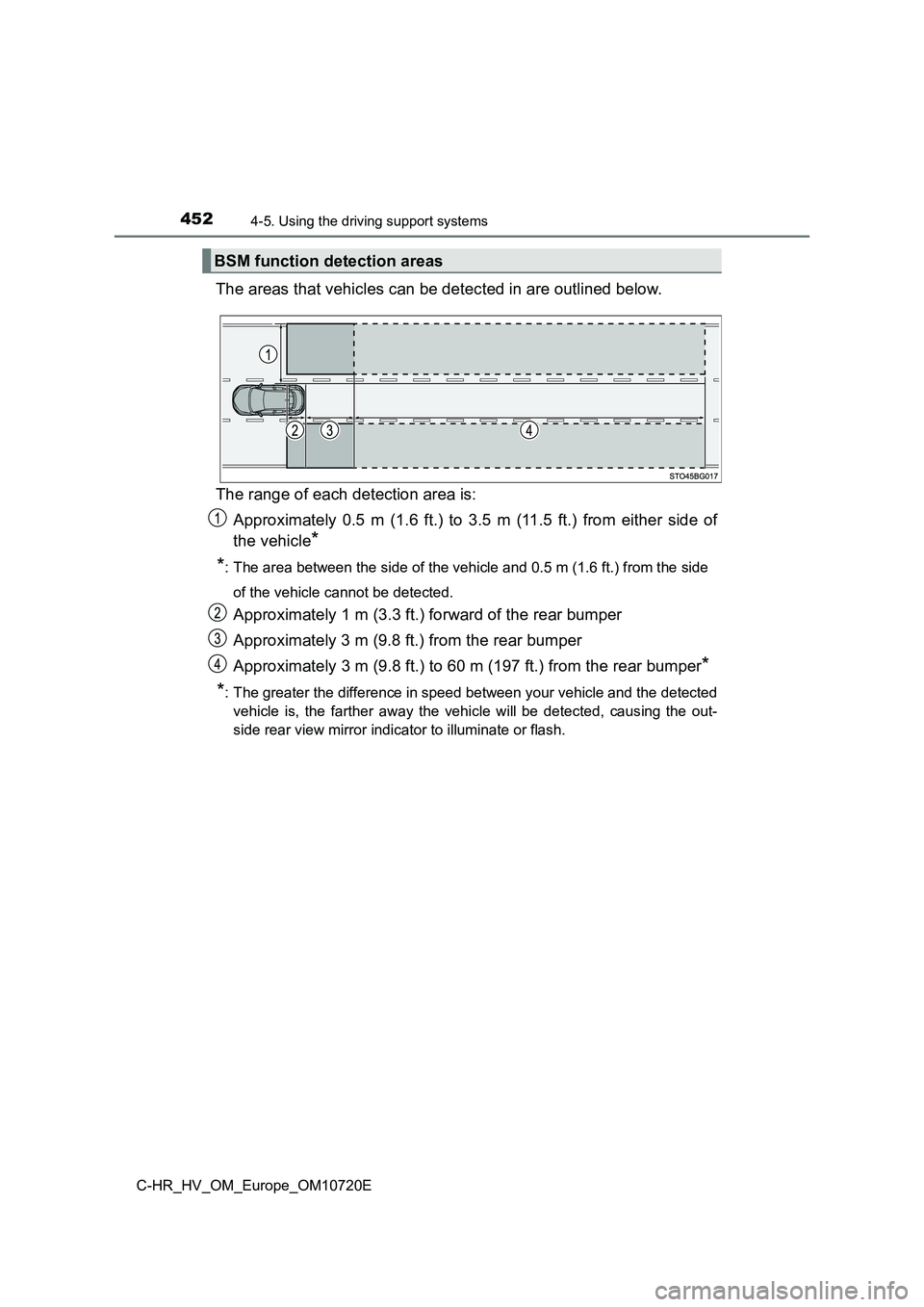
4524-5. Using the driving support systems
C-HR_HV_OM_Europe_OM10720E
The areas that vehicles can be detected in are outlined below.
The range of each detection area is:
Approximately 0.5 m (1.6 ft.) to 3.5 m (11.5 ft.) from either s ide of
the vehicle*
*: The area between the side of the vehicle and 0.5 m (1.6 ft.) f rom the side
of the vehicle cannot be detected.
Approximately 1 m (3.3 ft.) forward of the rear bumper
Approximately 3 m (9.8 ft.) from the rear bumper
Approximately 3 m (9.8 ft.) to 60 m (197 ft.) from the rear bum per*
*: The greater the difference in speed between your vehicle and t he detected
vehicle is, the farther away the vehicle will be detected, caus ing the out-
side rear view mirror indicator to illuminate or flash.
BSM function detection areas
Page 455 of 818
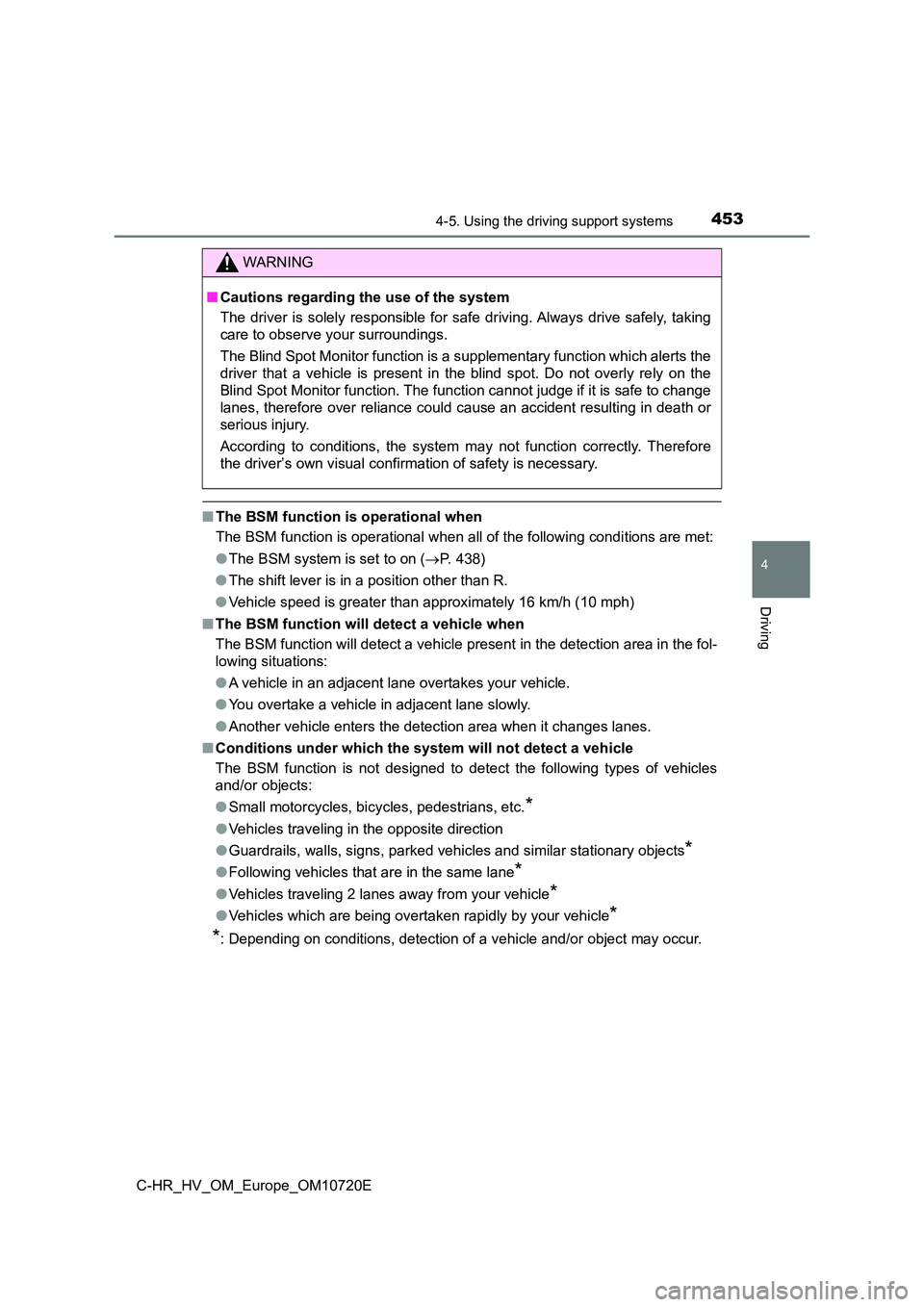
4534-5. Using the driving support systems
4
Driving
C-HR_HV_OM_Europe_OM10720E
■The BSM function is operational when
The BSM function is operational w hen all of the following conditions are met:
● The BSM system is set to on (P. 438)
● The shift lever is in a position other than R.
● Vehicle speed is greater than approximately 16 km/h (10 mph)
■ The BSM function will detect a vehicle when
The BSM function will detect a vehicle present in the detection area in the fol-
lowing situations:
● A vehicle in an adjacent lane overtakes your vehicle.
● You overtake a vehicle in adjacent lane slowly.
● Another vehicle enters the detection area when it changes lanes.
■ Conditions under which the system will not detect a vehicle
The BSM function is not designed to detect the following types of vehicles
and/or objects:
● Small motorcycles, bicycles, pedestrians, etc.*
●Vehicles traveling in the opposite direction
● Guardrails, walls, signs, parked vehicles and similar stationary objects*
●Following vehicles that are in the same lane*
●Vehicles traveling 2 lanes away from your vehicle*
●Vehicles which are being overtaken rapidly by your vehicle*
*: Depending on conditions, detection of a vehicle and/or object may occur.
WARNING
■Cautions regarding the use of the system
The driver is solely responsible for safe driving. Always drive safely, taking
care to observe your surroundings.
The Blind Spot Monitor function is a supplementary function whi ch alerts the
driver that a vehicle is present in the blind spot. Do not over ly rely on the
Blind Spot Monitor function. The function cannot judge if it is safe to change
lanes, therefore over reliance could cause an accident resultin g in death or
serious injury.
According to conditions, the system may not function correctly. Therefore
the driver’s own visual confirmation of safety is necessary.
Page 456 of 818
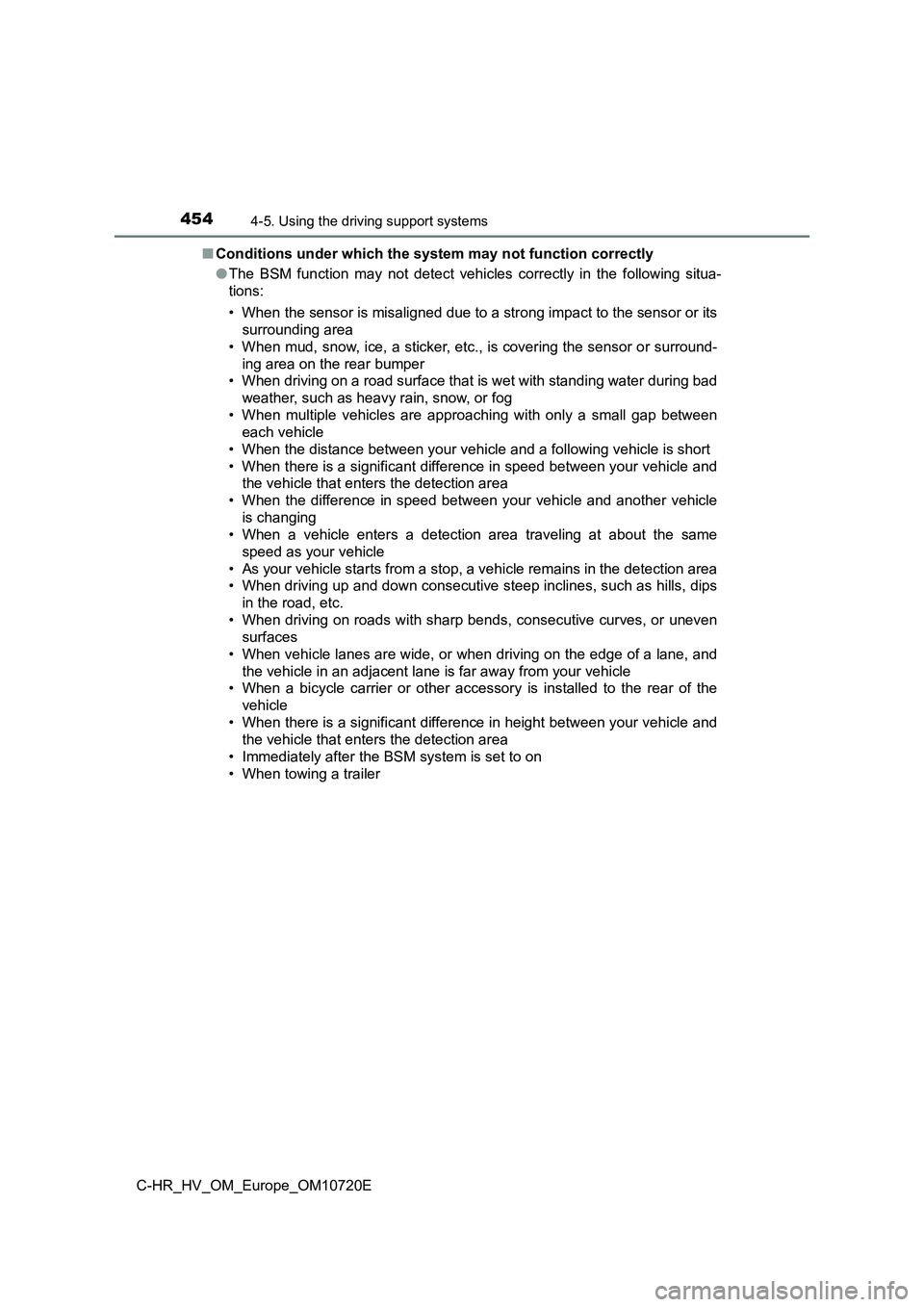
4544-5. Using the driving support systems
C-HR_HV_OM_Europe_OM10720E
■ Conditions under which the system may not function correctly
● The BSM function may not detect vehicles correctly in the following situa-
tions:
• When the sensor is misaligned due to a strong impact to the se nsor or its
surrounding area
• When mud, snow, ice, a sticker, etc., is covering the sensor o r surround-
ing area on the rear bumper
• When driving on a road surface that is wet with standing water during bad
weather, such as heavy rain, snow, or fog
• When multiple vehicles are approaching with only a small gap b etween
each vehicle
• When the distance between your vehicle and a following vehicle is short
• When there is a significant difference in speed between your v ehicle and
the vehicle that enters the detection area
• When the difference in speed between your vehicle and another vehicle
is changing
• When a vehicle enters a detection area traveling at about the same
speed as your vehicle
• As your vehicle starts from a stop, a vehicle remains in the d etection area
• When driving up and down consecutive steep inclines, such as h ills, dips
in the road, etc.
• When driving on roads with sharp bends, consecutive curves, or uneven
surfaces
• When vehicle lanes are wide, or when driving on the edge of a lane, and
the vehicle in an adjacent lane is far away from your vehicle
• When a bicycle carrier or other accessory is installed to the rear of the
vehicle
• When there is a significant difference in height between your vehicle and
the vehicle that enters the detection area
• Immediately after the BSM system is set to on
• When towing a trailer
Page 457 of 818

4554-5. Using the driving support systems
4
Driving
C-HR_HV_OM_Europe_OM10720E
● Instances of the BSM function unnecessarily detecting a vehicle and/or
object may increase in the following situations:
• When the sensor is misaligned due to a strong impact to the se nsor or its
surrounding area
• When the distance between your vehicle and a guardrail, wall, etc., that
enters the detection area is short
• When driving up and down consecutive steep inclines, such as h ills, dips
in the road, etc.
• When vehicle lanes are narrow, or when driving on the edge of a lane,
and a vehicle traveling in a lane other than the adjacent lanes enters the
detection area
• When driving on roads with sharp bends, consecutive curves, or uneven
surfaces
• When the tires are slipping or spinning
• When the distance between your vehicle and a following vehicle is short
• When a bicycle carrier or other accessory is installed to the rear of the
vehicle
Page 458 of 818
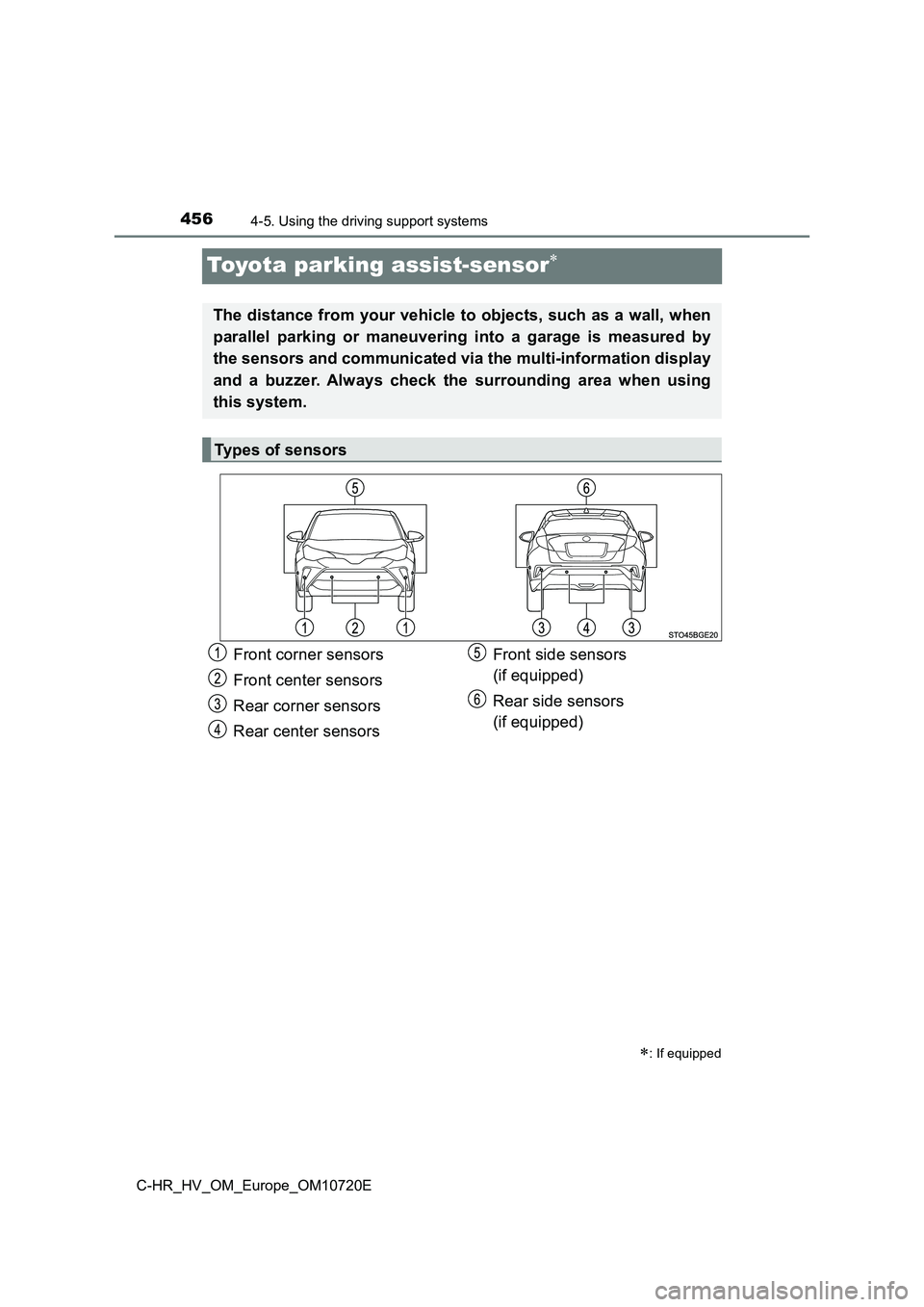
4564-5. Using the driving support systems
C-HR_HV_OM_Europe_OM10720E
Toyota parking assist-sensor
: If equipped
The distance from your vehicle to objects, such as a wall, when
parallel parking or maneuvering into a garage is measured by
the sensors and communicated via the multi-information display
and a buzzer. Always check the surrounding area when using
this system.
Types of sensors
Front corner sensors
Front center sensors
Rear corner sensors
Rear center sensors
Front side sensors
(if equipped)
Rear side sensors
(if equipped)
Page 459 of 818

4574-5. Using the driving support systems
4
Driving
C-HR_HV_OM_Europe_OM10720E
This system can be enabled/disabled on the multi-information display.
Press “ ” or “” of the meter control switches, select .
Press “ ” or “” of the meter control switches, select , and
press to select the desired setting (on/off).
When the Toyota parking assist-sensor function is disabled, the Toyota
parking assist-sensor OFF indicator ( P. 161) illuminates.
Once turned off, the Toyota parking assist-sensor will remain O FF until it
is turned ON again via the screen of the multi-information dis play.
(The system will not automatically turn ON even when the hybrid system
is restarted.)
When the sensors detect an objects, such as a wall, a graphic i s
shown on the multi-information display depending on the positio n and
distance to the objects.
● Multi-information display
Front center sensor detection
Front corner sensor detection
Front side sensor detection* (if
equipped)
Rear side sensor detection* (if
equipped)
Rear corner sensor detection
Rear center sensor detection
*: The side sensor displays are not shown until a scan of the sid e areas is
completed.
Enabling/disabling the Toyota parking assist-sensor system
Display
1
2
Page 460 of 818

4584-5. Using the driving support systems
C-HR_HV_OM_Europe_OM10720E
When an object is detected by a sensor, the approximate distance to
the object will be displayed on the multi-information display. (As the
distance to the object becomes short, the distance segments may
blink.)
The front side sensor displays and rear side sensor displays (i f
equipped) are not shown until a scan of the side areas is compl eted.
■Corner sensors
The distance display and buzzer
Approximate distance to
objectMulti-information displayBuzzer
60 cm (2.0 ft.) to
45 cm (1.5 ft.) Medium
45 cm (1.5 ft.) to
30 cm (1.0 ft.) Fast
30 cm (1.0 ft.) to
15 cm (0.5 ft.) Continuous
Less than 15 cm
(0.5 ft.) Continuous